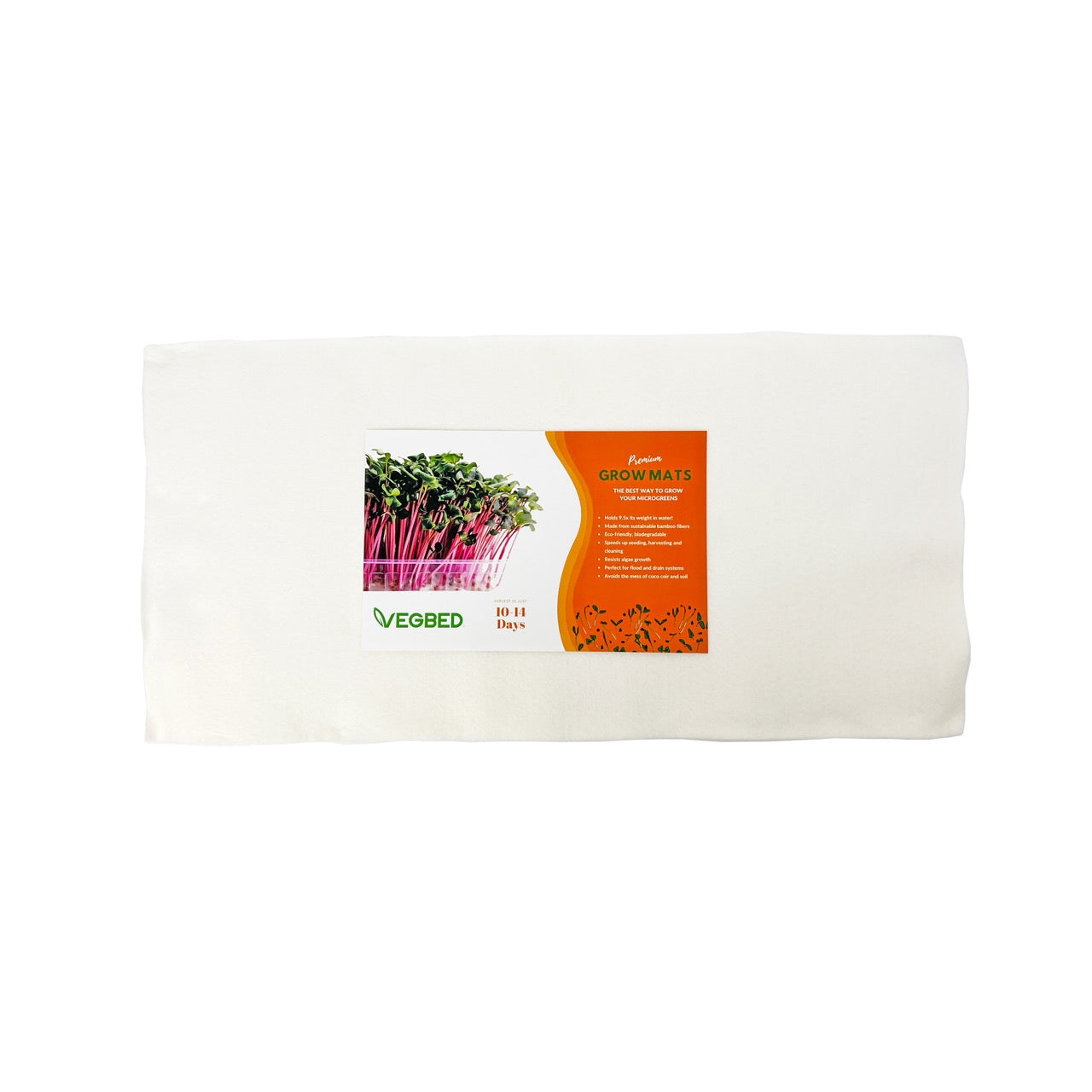Microgreens have quickly become a favorite among health-conscious foodies and home gardeners alike. These tiny, vibrant greens are packed with concentrated nutrients, often containing significantly higher levels of vitamins and minerals than their mature counterparts.
Microgreens are an excellent choice whether you’re looking to improve your diet, enhance your meals with fresh flavors, or grow a sustainable food source at home.
Why Are Microgreens So Nutrient-Dense?
Microgreens are harvested early in plant development, usually within 7-21 days after germination. Because they’re in their initial growth phase, their leaves (cotyledons) concentrate on vital nutrients, antioxidants, and enzymes, making them significantly more nutrient-dense than fully grown vegetables.
A study published in Frontiers in Plant Science analyzed 17 different microgreen varieties, revealing that they are rich in essential nutrients such as vitamin C, vitamin K, iron, and antioxidants. Another study in Food & Function confirmed that microgreens are excellent sources of minerals such as potassium, manganese, and iron, making them a nutritional powerhouse.
So, which microgreens are the best for maximizing health benefits? Here are the top 10 microgreens to grow for the highest nutritional value!
1. Red Cabbage Microgreens
🔹 Nutritional Power: High in vitamin C, vitamin K, and anthocyanins (powerful antioxidants).
🔹 Health Benefits: Supports heart health, reduces inflammation, and strengthens the immune system.
🔹 Scientific Backing: The Frontiers in Plant Science study found that red cabbage microgreens contain up to six times more vitamin C than mature cabbage and are rich in polyphenols that combat oxidative stress.
2. Broccoli Microgreens
🔹 Nutritional Power: Loaded with sulforaphane, a potent compound known for its anti-cancer properties.
🔹 Health Benefits: May help reduce cancer risk, improve digestion, and support detoxification.
🔹 Scientific Backing: Research indicates that broccoli microgreens contain up to 40 times more sulforaphane than fully grown broccoli, making them an incredible food for cellular protection.

3. Pea Shoots
🔹 Nutritional Power: Rich in vitamin A, vitamin C, folate, and plant-based protein.
🔹 Health Benefits: Supports muscle recovery, enhances immune function, and promotes eye health.
🔹 Scientific Backing: The Food & Function study found that pea microgreens have high potassium content, helping regulate blood pressure and heart health.

4. Sunflower Microgreens
🔹 Nutritional Power: Packed with vitamin E, magnesium, and healthy fats.
🔹 Health Benefits: Supports skin health, strengthens bones, and provides a great source of plant-based protein.
🔹 Scientific Backing: The Frontiers in Plant Science study highlighted sunflower microgreens as one of the best plant-based sources of magnesium, essential for nerve and muscle function.

5. Radish Microgreens
🔹 Nutritional Power: High in vitamins A, B, C, and E, along with glucosinolates.
🔹 Health Benefits: Aids digestion, promotes liver detoxification, and supports metabolism.
🔹 Scientific Backing: Studies show radish microgreens have high levels of antioxidants, which help reduce oxidative stress and inflammation.
6. Mustard Microgreens
🔹 Nutritional Power: Contains isothiocyanates, compounds with powerful anti-inflammatory properties.
🔹 Health Benefits: Supports digestion, improves metabolism, and may aid in cancer prevention.
🔹 Scientific Backing: Mustard microgreens were found to be particularly rich in glucosinolates, compounds known for their protective effects against chronic diseases.
7. Beet Microgreens
🔹 Nutritional Power: Excellent source of folate, betalains (antioxidants), and dietary fiber.
🔹 Health Benefits: Supports brain function, reduces inflammation, and improves blood circulation.
🔹 Scientific Backing: Beet microgreens contain higher folate levels than mature beets, which is crucial for brain and heart health.
8. Cilantro Microgreens
🔹 Nutritional Power: Rich in vitamin A, vitamin C, and essential minerals.
🔹 Health Benefits: Aids digestion, helps remove heavy metals from the body and supports immune function.
🔹 Scientific Backing: The Food & Function study highlights that cilantro microgreens have notably high levels of essential minerals, making them a nutrient-dense choice.
9. Wheatgrass
🔹 Nutritional Power: High in chlorophyll, vitamin E, and detoxifying enzymes.
🔹 Health Benefits: Promotes liver detoxification, alkalizes the body, and enhances energy levels.
🔹 Scientific Backing: Wheatgrass is widely studied for its ability to neutralize toxins and aid digestion, making it a popular superfood.
10. Amaranth Microgreens
🔹 Nutritional Power: Loaded with iron, calcium, and antioxidants.
🔹 Health Benefits: Supports bone health, boosts energy, and helps reduce inflammation.
🔹 Scientific Backing: Frontiers in Plant Science reported that amaranth microgreens contain significant iron levels, essential for red blood cell production.

Why Are Microgreens So Nutritious?
The secret behind microgreens’ incredible nutrition lies in their early growth stage. Unlike mature plants, microgreens concentrate nutrients in their first few leaves (cotyledons), making them up to 40 times more nutrient-dense than their fully grown counterparts.
Additionally, microgreens are exposed to photosynthesis, unlike sprouts, which boost their vitamin and antioxidant content. Research from Food & Function supports this claim, emphasizing that microgreens retain more bioavailable nutrients than sprouts.
💡 Curious about how microgreens compare to sprouts? Check out our guide: Microgreens vs. Sprouts: What’s the Difference?
How to Grow the Most Nutrient-Dense Microgreens at Home
Growing microgreens at home is simple and rewarding. Here’s what you need:
✔️ Quality seeds – Always opt for organic, non-GMO seeds to ensure purity and high nutrient content.
✔️ A reliable growing medium – Soilless options like Vegbed’s bamboo fiber mats provide a mess-free, eco-friendly way to grow microgreens indoors.
✔️ Proper lighting – Microgreens thrive under LED grow lights, ensuring maximum chlorophyll and nutrient development.
✔️ Ventilation and moisture control – Good airflow prevents mold growth, ensuring healthy microgreens.
For a step-by-step guide, check out our blog: How to Grow Microgreens Indoors: A Beginner’s Guide
Final Thoughts: Microgreens Are a Nutritional Powerhouse
If you're looking for a simple yet powerful way to boost your nutrition, microgreens are one of the best superfoods you can grow at home. Their high concentrations of vitamins, minerals, and antioxidants make them more than just a garnish—they’re a functional food with profound health benefits.
🌱 Want to start growing your own? Explore our microgreen grow mats and supplies at Vegbed!



